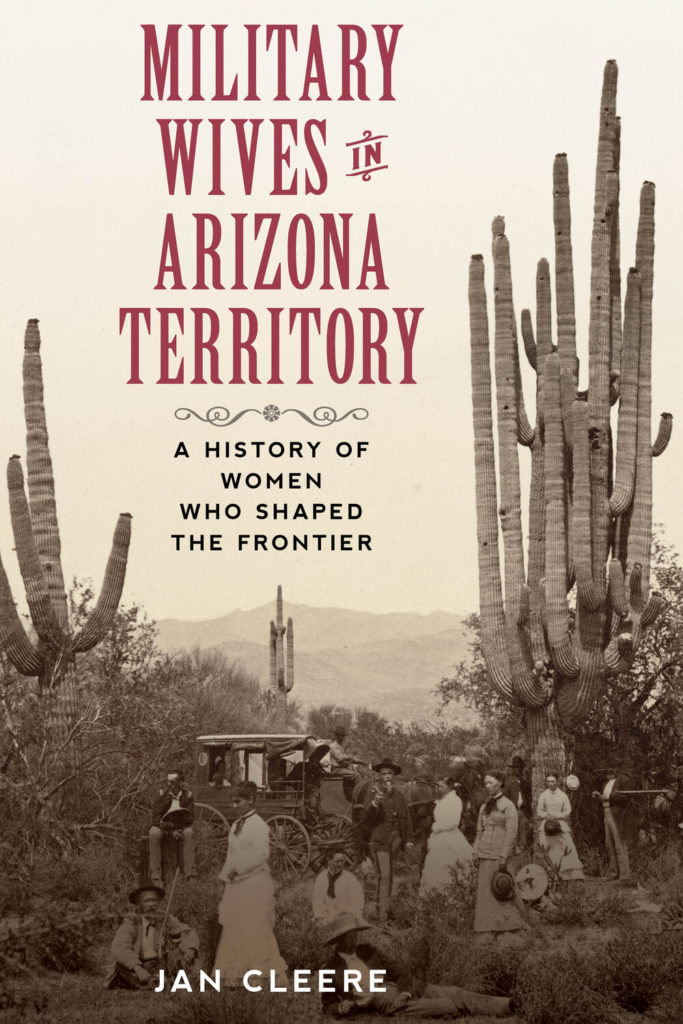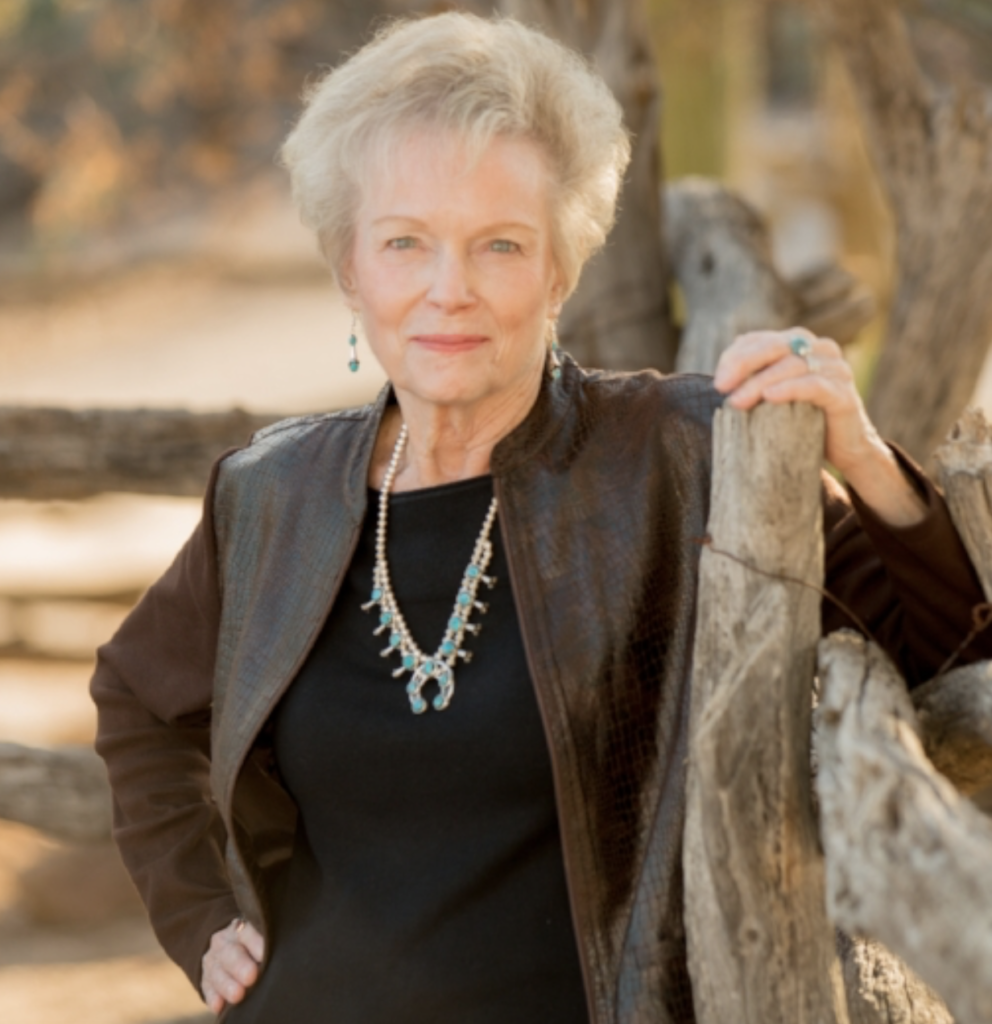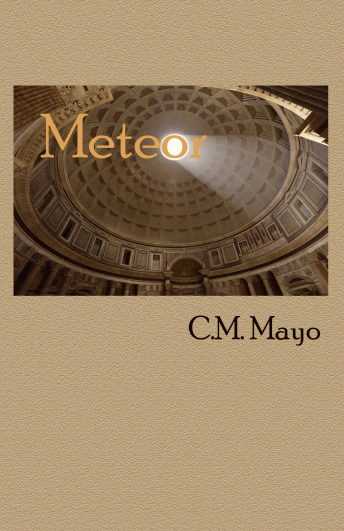
“I was actually working on another project when I stumbled across a handful of journals written by women who had come west with their military husbands in the mid to late 1800s. I became fascinated with what these women endured crossing the desert and settling in Army forts ill-prepared to accommodate women. I also wanted to present their stories as they wrote them which means in today’s climate their words are not always politically or socially acceptable, but I felt they needed to tell their stories”—Jan Cleere
This blog posts on Mondays. Fourth Mondays of the month I devote to a Q & A with a fellow writer.
Jan Cleere’s Military Wives in Arizona Territory tickled my curiosity for two reasons. First, as those of you who follow this blog well know, I am at work on a book about Far West Texas, and its post-Civil War US military conquest is closely connected to that of Arizona. Early on in my researches I came across the writings of Lt. John Bigelow, Jr. on both Texas and Arizona, and—also essential for anyone looking at Far West Texas history— The Colonel’s Lady on the Western Frontier: The Correspondence of Alice Kirk Grierson, edited and introduced by Shirley Anne Leckie. Historians, among them, Cleere— already the celebrated author of several works on women’s history in the West— are doing important work to bring forth these long-neglected women’s letters, diaries and more. I salute Cleere and sincerely hope that her work inspires others. (And by the way, if you have inherited such papers— whether pertaining to the West or any other time and place—please consider finding a home for them in an historical society or library.)
Secondly, I’m always interested—and I assume many of my writerly readers are as well—in how historians, biographers, nonfiction writers of various stripes and writers of historical fiction work with and manage books, articles and digital materials. My own experience I would describe as an ongoing slog up the learning curve, so I’m always game to ask about that and learn what I can from other writers.

From the copy catalog for Military Wives in Arizona Territory:
When the US Army ordered troops into Arizona Territory in the nineteenth century to protect and defend newly established settlements, military men often brought their wives and families, particularly officers who might be stationed in the west for years. Most of the women were from refined, eastern-bred families with little knowledge of the territory. Their letters, diaries, and journals from their years on army posts reveal untold hardships and challenges. They learned to cope with the sparseness, the heat, sickness, and danger, including wildlife they never imagined. These women were bold, brave, and compassionate. They became an integral part of military posts that peppered the West and played an important role in civilizing the untamed frontier. Combining their words with original research and tracing their movements from post to post, this collection of historical narratives explores the tragedies and triumphs that early military wives experienced.

C.M. MAYO: What inspired you to write Military Wives in Arizona Territory?
JAN CLEERE: I was actually working on another project when I stumbled across a handful of journals written by women who had come west with their military husbands in the mid to late 1800s. I became fascinated with what these women endured crossing the desert and settling in Army forts ill-prepared to accommodate women. I also wanted to present their stories as they wrote them which means in today’s climate their words are not always politically or socially acceptable, but I felt they needed to tell their stories with little interference from me.
C.M. MAYO: As you were writing, did you have in mind an ideal reader?
JAN CLEERE: Not specifically an ideal reader but one who enjoyed reading women’s history and who had an interest in how women coped during the early days of western development and expansion.
C.M. MAYO: Of the military wives, is there one who especially impressed you, surprised you, and/or frustrated you in some ways?
JAN CLEERE: A couple women stood out for different reasons.
One woman was so determined to accompany her husband into the territory that she defied her husband, sold all their belongings to pay passage for her and her infant son and joined him on the long march across the desert from California to Arizona’s Fort McDowell.
Another woman, fearing for her children’s lives during an Indian uprising at Fort Apache, lined her children up against the fireplaces in her home, hoping the resilient breastwork would protect them from flying bullets.
I was impressed with how these women reacted quickly to whatever the situation demanded.
C.M. MAYO: Which writers have been the most important influences for you?
JAN CLEERE: Because my books concentrate mainly on early Arizona, Tom Sheridan and C.L. Sonnichsen’s books are a mainstay in my library. I also find myself picking up old Arizona history books such as Thomas Farish’s 1915 History of Arizona and James McClintock’s 1916 3 volume set Arizona.
C.M. MAYO: Which writers are you reading now?
JAN CLEERE: Since my books require my delving into so much history, I like to read fiction for pleasure although the books that have stood out for me are historical. Jim Fergus’ 1000 White Women and The Wild Girl stand out as exceptional novels. But right now I am reading Pat Conroy’s memoir The Water is Wide.
C.M. MAYO: Researching a book like this requires extraordinary organizational skills. Can you talk a little bit about your working library and how you keep track of the books you read / consulted for Military Wives?
JAN CLEERE: I am certainly not an organized researcher or writer. I dedicate an area on my bookshelf for the books I use for a particular project and am scrupulous about documenting my sources but I have no strict method of organizing my materials. I am trying out the References feature in Word now to see if that will help me in future projects to maintain a record my sources.
C.M. MAYO: How do you keep track of articles, both on-line and on paper?
JAN CLEERE: I started this book before the pandemic and completed it during the crisis. Online research became more important than ever. I gave each women considered for the book an online as well as physical file. Research notes on each woman were cataloged under her name. General information about the military forts and how women were treated and perceived at the time was kept in separate files.
I utilize both digital and paper records for my research and am sometimes redundant with what I collect. One tool that I find very useful is a timeline detailing the life of each person I am researching as well as a timeline of historic events that occurred during her lifetime.
C.M. MAYO: Any other tips to share / hard-earned lessons in organizing one’s research?
JAN CLEERE: I am always looking for a better way to organize my research and am open to any suggestions. I have tried several types of software but have not yet found one that answers all of my needs. One thing I will emphasize is to back up your work constantly. In the past, I have lost valuable material and learned my lesson. I have both a physical backup on my computer as well as using the iCloud for storage. Redundancy can be a saving tool.
C.M. MAYO: How has the Digital Revolution affected your writing? Specifically, has it become more challenging to stay focused with the siren calls of email, texting, blogs, online newspapers and magazines, social media, and such? If so, do you have some tips and tricks you might be able to share?
JAN CLEERE: While digital sources have made a writer’s job more efficient when it comes to finding pertinent sources, it has also taken away that spontaneous delight of uncovering a long lost letter or hidden journal that has not yet been digitized.
I try to focus on the business of writing separate from the hours I spend actually writing. Not always possible but I have found by trying to compartmentalize the creative from the business end of writing, I am more productive. The trick is to balance these activities so that by the end of the day, you feel you have put out all the fires as well as progressed with your writing.
C.M. MAYO: For those looking to publish, what would be your most hard-earned piece of advice?
JAN CLEERE: Do your research before querying publishers and agents. You will save so much time if you know whether the publisher or agent you are querying accepts the type of book you are writing. There are several good websites that list publishers and/or agents and describe what they are looking for.
C.M. MAYO: What’s next for you as a writer?
JAN CLEERE: I am researching the lives of women who ran boardinghouses in the early west and have run across some remarkable stories of why and how these women started taking in boarders, how the business changed their lives and those of their children. The majority of the book will be about respectable landladies but I have also run across a handful of women who operated bordellos and might include some of them.
And I continue to write my monthly column, “Western Women,” for Tucson’s Arizona Daily Star newspaper.
Excerpt from Military Wives in Arizona Territory by Jan Cleere:
Ellen Biddle and Martha Summerhayes had already lived on a variety of military posts before meeting each other in Ehrenberg, Arizona, where Ellen experienced an incident that would stay with her long after she and Martha parted.
On her way to Fort Whipple in 1876, Ellen traveled up the Colorado River from Fort Yuma toward Ehrenberg with her husband and young daughter aboard a small steamer called “The Cocopah.”
“We reached Ehrenberg just before sundown four days after leaving Fort Yuma,” she wrote in her journal. “It was only a depot for supplies that were shipped to the forts in all parts of the Territory; and here, entirely isolated from the world, lived Lieutenant and Mrs. Jack [Martha] Summerhays [sic]. . . . They were very glad to see us and gave us the warmest welcome, though we had never before met.
“We had a very good dinner, notwithstanding it was so far out of the world, for most army women learned to cook and make the best of everything that came within reach. I was somewhat surprised when a very tall, thin Indian came in the dining-room to serve the dinner, which he did quite well.
“There was much to talk about before I thought of putting my little one to bed, and I asked Mrs. Summerhays if I might have a tub of warm water to give Nelly a bath.
“In a little while she told me it was ready in my room (which I soon learned was her own she had given up to me). We said good-night, and going to the room I undressed the child and gave her a refreshing bath, the first that she had had since leaving San Francisco. She soon fell asleep and after I had straightened the room a bit, I decided I would get in the tub. I had just sat down in the water when my room door was silently opened and in walked the tall Indian carrying a tray filled with silver before him. I scarcely breathed so great was my fright. He walked over to the table, put the tray down, and as silently walked out, looking neither to the right or the left. It is useless for me to attempt to describe what I felt, it would convey nothing.”
Martha was not as distressed with half-naked Natives as was Ellen. She described her servant Charley who interrupted Ellen’s bath as appealing “to my aesthetic sense in every way. Tall and well made, with clean-cut limbs and features, fine smooth copper-colored skin, handsome face and features, heavy black hair done up in pompadour fashion . . . wide turquoise bead bracelets upon his upper arm, and a knife at his waist—this was my Charley.”

Q & A with Sergio Troncoso, Author of
A Peculiar Kind of Immigrant’s Son
The Marfa Mondays Podcast is Back! No. 21:
“Great Power in One: Miss Charles Emily Wilson”
On Seeing as an Artist or, Five Techniques for a Journey to Einfühlung
*
My new book is Meteor

